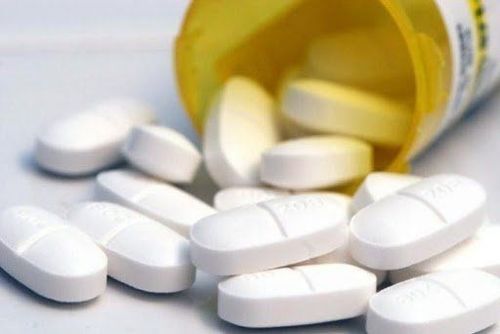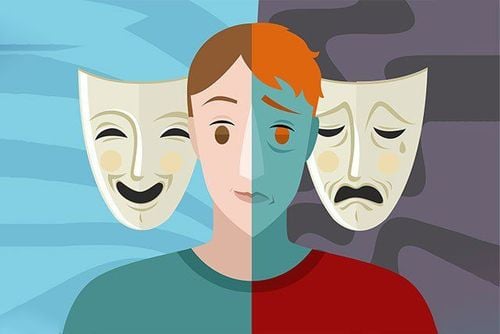This is an automatically translated article.
Bipolar affective disorder is a disease characterized by mood swings alternating between mania and depression. In some cases, the patient may develop a chronic illness and the use of the drug may need to last a lifetime.
1. What is bipolar disorder?
Bipolar disorder can be common in both men and women, starting between the ages of 20 and 30, with an incidence of about 4% of the population. Bipolar disorder is a condition in which people experience alternating episodes of mania and depression, with periodic flare-ups, periods of recovery, and then relapses.
People with bipolar disorder have no known cause, possibly genetic factors. In addition, some factors that lead to the disease may be encountered such as psychological factors, stress in life, some drugs such as sympathomimetic are also factors that trigger the disease.
Some signs of disease:
The disease will appear in stages, each stage can last from 3 to 6 months, then there will be a stable phase with almost all symptoms. Manic phase: Mood is elevated with manifestations such as talking a lot, very quickly, feeling happy, enjoying activities and being constantly stimulated, increased self-esteem or exaggeration, easily distracted but with increased memory, it is easy to engage too much in high-risk activities, and these people often sleep very little each day, but do not feel tired. Usually this stage lasts for at least 1 week and usually lasts about 3 months. Stable stage: The patient usually no longer has any symptoms and thinks he has recovered from the disease, lasting about 1 year. A very small number still have residual symptoms and may affect the ability to function. Depressive episode: Low mood with symptoms such as feeling sad, tired, significantly reduced interest or enjoyment in all or most activities of the day, significant weight gain or loss , decreased or increased appetite, insomnia or sometimes a lot of sleep, fatigue or loss of energy, impaired ability to think or concentrate, indecision, negative thoughts about death or suicide, a suicide attempt, or a specific suicide plan. Symptoms occur for at least two weeks and it usually lasts about 6-9 months and then comes back to almost complete recovery. Usually, when suffering from bipolar affective disorder, the patient appears alternating the above different periods, stabilizes, and then relapses, the disease will last for almost a lifetime with a very high rate and the medication also requires medication, lifelong symptom management.
2. Is bipolar disorder dangerous?
Patients with bipolar affective disorder need to be detected and closely controlled because it can cause some dangerous problems as follows:
If in the manic phase, the patient can invest financially into jobs they don't know well, causing economic losses to their families. Suicidal behavior: People with a depressive episode are at risk of suicide and self-harm. People with bipolar disorder have a suicide rate 15 times higher than the general population. Decreased ability to work, increased illegal actions such as sexual abuse, feeling abused, so there will be more aggressive behaviors, causing damage to others. Thus, bipolar disorder is a dangerous disease because it can cause loss of life for both yourself and those around you. It is necessary to detect and treat to help control the disease well.
3. Treating Bipolar Disorder With Medicine
Bipolar affective disorder requires a combination of medication or, in some cases, electrical shock therapy.
3.1 Choosing medication for bipolar disorder Choosing medication for bipolar disorder can be challenging due to side effects and drug interactions. The choice of drug depends on many factors such as the ability to respond to the drug, unwanted effects that the patient encounters when taking the drug and the severity of the disease:
3.1.1. Treatment of the acute episode Depressive episode
Unlike major depression, the depressive episode of bipolar disorder often responds very well to new sedation. Many times bipolar disorder requires only new antipsychotic treatment without the use of antidepressants.
The recommended drugs are quetiapine at a dose of 300mg/day, olanzapine 10mg/day. If, after 3 weeks of treatment with sedatives, depressive symptoms do not decrease by more than 30% of the number of symptoms, it must be combined with an antidepressant. Some patients with depression and psychosis, suicidal ideation or behavior, and refusal to eat and drink need an antidepressant combination from the start.
Some antidepressant options include:
Tricyclic antidepressants: Tricyclic antidepressants are better indicated than SSRIs in cases of depression with multiple symptoms such as insomnia, loss of appetite, fatigue fatigue, headache, abdominal pain, joint pain... After treatment, the effect is usually given after 2 to 4 weeks. The commonly used tricyclic antidepressants such as: Amitriptyline with a dose of 75-200 mg / day, an average of 100 mg / day, divided into 2 times (morning and evening). Clomipramine used with 50-150mg / day, an average of 75mg / day, can be taken 1-2 times a day. Tianeptin takes 12.5mg/day, takes 3 tablets, should be taken at 7am, 3pm and 10pm. Polycyclic antidepressants: Polycyclic antidepressants are as effective in treating depression as tricyclic antidepressants, but generally have fewer side effects and are better tolerated. The drug commonly used is Mirtazapine dose 14-45mg / day, once a day. Venlafaxin (effexor, velift) is administered at a starting dose of 37.5 mg once after dinner, then the dose can be increased by 37.5 mg every 5 days until the therapeutic dose is reached. Selective Serotonin Reuptake Inhibitors (SSRIs): A new type of antidepressant that selectively acts on the serotonin system. The drug has almost no effect, the drug is well tolerated and has very few side effects. Some drugs such as Fluoxetin (prozac, oxeflu, oxedep) with an antidepressant dose of 20-40 mg/day, taken once only after breakfast. Fluvoxamine (luvox) dose 100-200 mg/day, divided into 1-2 times. Manic and mixed phase
During this phase, a combination of mood stabilizers and sedatives is required. Do not take antidepressants during this period.
Sedatives: Benzodiazepines can be used, which are effective in the early stages of the disease (reducing insomnia and agitation). Mood stabilizers: Commonly used mood stabilizers such as lithium, valproate, carbamazepine and oxcarbazepine, lamotrigyl, topiramate have been shown to provide good treatment for manic and mixed episodes. After 6-8 weeks of treatment, the effect of mood stabilizers on manic episodes is comparable to that of sedation. Mood stabilizers are also used to prevent and prevent recurrence of manic and mixed episodes. They also do not have side effects such as extrapyramidal movement, acute muscle spasticity, tardive dyskinesia... as sedatives. However, because the effect of the drug appears to be slower than that of sedative drugs, in clinical practice, people often combine these two drugs to treat patients. Lithium: It is highly effective in treating manic episodes (70-80% of patients). The therapeutic dose is in the range of 0.6-1.2 mEq/l. If you use the drug below this dose, the treatment effect is very poor, but an overdose of 1.2 mEq/l will cause acute lithium toxicity. In clinical practice, an average dose of 20 mg/kg body weight/day can be calculated. Valproate (valparin): In multiple clinical trials, valproate was as effective in treating manic episodes as lithium, haloperidol, and olanzapine. The safe dose of valproate is 20-30 mg/kg body weight per day, when the effect of the drug will appear fastest. Carbamazepine (antiepileptic drug) has been used for a long time to treat manic episodes, the therapeutic effect of which is thought to be equivalent to that of lithium and clopromazine, but less than valproate. However, it is rarely used in the treatment of bipolar affective disorder. Oxcarbazepine: Many people recommend oxcarbazepine as an alternative to carbamazepine because its effectiveness in treating manic episodes is similar, but oxcarbazepine has fewer side effects. Dosage is 20-30mg/kg body weight. Lamotrigyl: The effectiveness of this drug for manic episodes is thought to be similar to that of carbamazepine, but it has a lower risk of allergic reactions. The average dose is 200mg / day, should be divided into 2 times / day. Stabilization Treatment
Stabilization therapy helps patients maintain steady state and reduce relapses.
During this period, the patient is used mood-modifying drugs. Dosage of mood-modifying drugs at this stage is usually lower than those used in the attack phase, depending on the drug. For patients after a depressive episode, a combination of antidepressants should be used for at least 6 months with mood stabilizers for many years. For manic cases: continue taking maintenance doses of mood stabilizers such as Valproat, Oxcarbazepine... The duration of treatment in the stable phase is many years, because only about 7% of people suffer from the disease. can go away. Most of the rest are chronic and long-lasting, so the patient has to take the drug for the rest of his life. 3.2 Notes on drug use If after a period of drug treatment, the patient does not respond and is in remission, it is necessary to review the diagnosis, choose a good drug or not and adjust the dose accordingly. Patients who have been taking the correct medication but have not been effective should be treated with electroconvulsive therapy if the behavior is abnormal. Patients need to re-examine and consult their doctor when taking other drugs to treat this disease. Some medications can affect pregnant women, causing birth defects in the unborn baby. Therefore, if you are taking medication and you intend to become pregnant, you need to see your doctor to adjust the dose and type of medicine. Manage medication well, avoid low doses that have no therapeutic effect and high doses increase the risk of side effects. Especially in the elderly. Patients need to understand that the disease can return when the drug is stopped, so remember that the medication needs to be maintained. Here is some information about taking medication for bipolar disorder. If there are problems or suspected disease, the patient should visit the doctor for advice and early treatment.
Please dial HOTLINE for more information or register for an appointment HERE. Download MyVinmec app to make appointments faster and to manage your bookings easily.













